| Pages:
1
2
3 |
jdowning
Oud Junkie
    
Posts: 3485
Registered: 8-2-2006
Location: Ontario, Canada
Member Is Offline
Mood: No Mood
|
|
Thanks for the explanation Richard. I also tried a test with a 3/8" thick piece of pine laid over a length of 2" square cedar - figuring that there
might be a scale effect - but the readings were totally random and inaccurate which confirms what you say. Pity.
I am going to try your suggestion of vibrating the sound board but am not sure that I would want to use sand but I suppose that there might be a
critical particle size so will experiment a bit.
|
|
|
zalzal
Oud Junkie
    
Posts: 747
Registered: 12-9-2005
Location: Nîmes France
Member Is Offline
Mood: still alive
|
|
There is a radiographie of an oud in Wissam Joubran site
http://www.wissamjoubran.com/fr/Photos
|
|
|
ALAMI
Oud Junkie
    
Posts: 645
Registered: 12-14-2006
Location: Beirut
Member Is Offline
Mood: No Mood
|
|
The Al Arja Bracing is interesting:
The bracing is very thin but it survived 115 years in bad conditions, in a humid city and when I found it wasn't even in a case or even a linen bag
(like old ouds)
_8 full length braces (there is one under the last line of text
_2 fan braces on the bridge level
_No horizontal braces around the hole
I don't have enough experience to draw any conclusions I will let this to the experts. Even though the shape is identical to De Zwolle manuscript the
barring is different.
Regarding the scan experience I can tell only what I learned from the radiologist and it should not be considered as a scientific reference
The scan in fact can have many resolutions (measured in mm in terms of increment, or slices), the radiologist did a full scan for the Fan braces
region and for the brace that is just in front of the bridge in the direction of the hole. When I say a full scan it is the scan that outputs full 3D
data, in this sense the full bowl scan is not a full scan it is a general view that is not highly accurate on the edges resulting in a distortion that
is easily fixed, the general view is limited to 50 cm in scaner He used, may be it is enough for lutherie use, I don't know.
Ideally the instrument can be scanned in small slices and a full 3D model can obtained and delivered on CD with its viewing and measuring software.
This scan can take between half an hour or 2 hours depending on resolution and scan speed. But the study and the measurments can be done later on by
the researcher on any PC using the free software that is on the CD.
Voila
|
|
|
Ronny Andersson
Oud Junkie
    
Posts: 724
Registered: 8-15-2003
Location: Sweden
Member Is Offline
Mood: No Mood
|
|
| Quote: | Originally posted by ALAMI
John you're right !
A quick and rough superposition with the manuscript (as posted by Ronny Anderson)
What are the possible conclusions ?
An oud made in Tripoli - Lebanon in 1892 is "according" to De Zwolle manuscript 1450, pure coincidence ? or shared ancient ways ?
|
This is extremely interesting since some consider Zwolle's description to be ¨theoretical¨ and not authentic for the lutes of the period.
Best wishes
Ronny
|
|
|
jdowning
Oud Junkie
    
Posts: 3485
Registered: 8-2-2006
Location: Ontario, Canada
Member Is Offline
Mood: No Mood
|
|
A 'standard' lute barring for the early 17th C is given by Marin Mersenne in his "Harmonie Universelle", Paris, 1636. (I gave a translation of the
relevant passage some time ago on this forum so it is not necessary to repeat it again here).
To summarise, Mersenne gives the bar placement on the belly of a lute by dividing the belly into 8 equal parts from the bottom of the belly (point 0)
to the lower edge of the neck block (point 8). The rose centre is positioned at point 5. Bars are positioned at points
2, 3, 4, 5, 6 and 7 (ie the bar at point 5 runs across the centre of the rose). The distance between point 0 and point 2 is divided into 3 equal parts
and the bridge is located on part 2. Mersenne then states that some makers add additional bars - if the belly is not well supported in places - as
well as smaller bars below the bridge.
The attached image of an early 16th C Italian lute belly (Magno Tieffenbrucker, 1609) illustrates Mersenne's barring arrangement quite well. The belly
also has evidence of scribed marks made with dividers used by the maker to lay out the belly geometry. In this case the layout differs only in that
additional bars are placed on each side of the bar on point 5, and there are two bars equally spaced on either side of point 7 in place of a single
bar.
Lutes of this period did not have a large end block at the lowest part of the bowl (as is current oud practice) but instead had a thin end plate to
provide additional reinforcement and stiffness of the bowl at this location. Additional stiffness in the area below the bridge - in the absence of an
endblock - was provided by additional bracing (a bass bar and diagonal treble bar) - typically as shown in the image.
The barring of ALAMI's Al Arja oud matches the Mersenne barring closely if the inside edge of the bottom block is taken as point 0 (and not the bottom
of the bowl) - except for the below bridge bar (which is located in the same position as the bass bar as well as the diagonal treble bar on the lute),
as well as the additional bar placed close to the neck block.
|
|
|
jdowning
Oud Junkie
    
Posts: 3485
Registered: 8-2-2006
Location: Ontario, Canada
Member Is Offline
Mood: No Mood
|
|
Just for information. To continue with more about barring, the Egyptian(circa 1920 but might be earlier?) oud that I am currently restoring on this
forum is unusual in several aspects of its construction which seem to be more lute than oud like. For example, it does not have a bottom block but
instead has a thin end plate (about 2mm thick tapering to a thin edge all around) as would be found on a lute except that the end plate does not
extend to the edge of the bowl and so does not provide direct stiffening of the belly in this location. Instead, the banding around the edge of the
belly (which provides a controlled weakness around the edge of the soundboard) does not extend to the bottom edge of the bowl but stops for a distance
of about 250 mm below the bridge position. This unusual feature I now believe is an indication that the belly is original and not a later
replacement.
To summarise, it would seem that additional stiffening of the area of the soundboard below the bridge (ie between bridge and bottom of the belly) is
an important feature of both early oud and lute design. This additional stiffening may be provided by a thick bottom block (as in the Arnault lute),
thin end plates, an additional bar below the bridge (a feature of ouds but not surviving lutes), 'fan' bracing below the bridge or a combination of
these.
|
|
|
jdowning
Oud Junkie
    
Posts: 3485
Registered: 8-2-2006
Location: Ontario, Canada
Member Is Offline
Mood: No Mood
|
|
I should add that the Egyptian oud in the previous posting has another unusual (?) feature in that the lower part of the soundboard that does not have
any edge banding (binding) already noted was covered by a narrow strip of thin, green coloured leathercloth (also known as faux leather or
leatherette) glued in place. The purpose of this was originally probably twofold - to further reinforce that part of the sound board and to protect
the edge from damage.
It occurred to me that this is another 'lute like' feature. Lutes of the 17th C/18th C that did not have protective edge banding often had the
soundboard edges protected with a 'lace' - that is a narrow strip of thin parchment glued in place covering the soundboard/bowl joint.
So far, I have not been able to find when leathercloth was first manufactured but it has certainly been used for binding books since the mid19th C
(and, of course, in its more modern form with synthetic plastic coatings is widely used today). This, however, does not help much in dating the oud as
early types of leather cloth were used well into the 20th C prior to the invention of plastic coatings.
|
|
|
Ronny Andersson
Oud Junkie
    
Posts: 724
Registered: 8-15-2003
Location: Sweden
Member Is Offline
Mood: No Mood
|
|
For what is worth I have seen the Tunisian Kuitra with an edge covered with leather. There is one in a Swedish museum from I believe early 19th
century with this detail. Sometimes you find also leather/cloth glued on the lower part of the soundboard in a very decorative pattern.
Best wishes
Ronny
|
|
|
jdowning
Oud Junkie
    
Posts: 3485
Registered: 8-2-2006
Location: Ontario, Canada
Member Is Offline
Mood: No Mood
|
|
The geometrical construction of a 15th C lute given by Arnault de Zwolle does not quite match the profile and sound hole position of the Al Arja
oud.
In an article "Lute Design and the Art of Proportion" by Gerhard C. Sohne, the author proposes a geometrical construction, of elegant simplicity, for
an early 16th C lute - based upon the familiar 'Pythagorean' right triangle having a hypotenuse measuring 5 units and the other two sides measuring 3
and 4 units respectively. The construction is given in Fig.1
No lutes of this design survive so Sohne selected an example from the iconography as evidence that the proposed geometry was an historical
possibility. The carving of Pythagoras playing a lute by Jorg Syrlin the Elder (c. 1470) is in Ulm cathedral, Germany. While the profile of the lute,
sound hole diameter and position match the geometry closely, the length of the fretboard is too short as it is only of sufficient length for 7 frets -
not 8. However 7 frets to the neck joint would have been typical for a lute of the 15th C (as it also would have been for an oud of the Medieval
period).
Although no lutes of this design survive there are some old ouds that do seem to conform to the geometry. One is the Al Arja oud - except that the Al
Arja oud has the traditional length of fingerboard that is 1/3 string length.
Working with a high resolution "full face" image of the oud - taken with a long focus lens to minimise any optical distortion (kindly provided for
this exercise by ALAMI) - the geometry was modified slightly (Fig. 2) to obtain the very close match evident in the attached overlay image. Note that
the neck length is a few mm short of 1/3 string length due to loss of material caused by repeated repairs and adjustments to the neck over time. Also
note that the actual sound hole diameter is the diameter of the open area of the rosette pattern. The centre of the soundhole is a distance of 1/3
string length from the neck joint - i.e. according to oud traditional design.
This result suggests a possible connection with early oud design in the Middle East and lute design of 15th C Northern Europe.


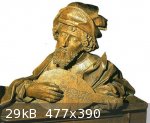
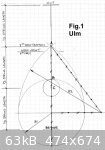

|
|
|
Dr. Oud
Oud Junkie
    
Posts: 1370
Registered: 12-18-2002
Location: Sacramento, CA, USA
Member Is Offline
Mood: better than before
|
|
The research an information shared by everyone is astounding. I am very impressed and thankful that so many have spent so much of their time to help
solve this mystery. I now feel like I have sufficient information to restore this oud to something close to it's original design. I have been reducing
my work load this year in order to restore more of my collection of broken old ouds, and this one will definitely get on the bench soon. Thanks to
everyone, with special appreciation to Alami and jdowning for their valuable input.
|
|
|
jdowning
Oud Junkie
    
Posts: 3485
Registered: 8-2-2006
Location: Ontario, Canada
Member Is Offline
Mood: No Mood
|
|
Good luck with the restoration project Richard. I look forward to seeing how it turns out.
I was in a bit of a rush to post the details of the Ulm lute/Al Arja oud geometry so will add the following comments for further clarification -
although it should be self evident from the geometrical layouts.
Location of the neck joint at 1/3 string length is the Pythagorean ratio of 3/2.
The Al Arja geometry starts with the sound board profile determined with the Pythagorean 3:4:5 right triangle as its basis. The width of the the sound
board is 4 units. the bridge is 1 unit from the bottom of the sound board The neck joint position is then determined knowing the width of the
fingerboard at the neck joint (about 55 mm for a six course oud).
The top of the sound hole is located at B - 4 units from the bottom of the sound board. The distance from neck joint to bridge is then halved to give
the location of the centre of the sound hole. This gives a sound hole centre that is bit lower than that given by Sohne's geometry and so results in
the larger sound hole diameter matching that of the Al Arja geometry.
The most popular prevailing theory is that the European lute came from the oud of Moorish 'Spain'. However, the other possibility is that it may have
been introduced to northern Europe directly from the 'Middle East' (Persia via Turkey perhaps?) as a result of the historical connection of the so
called 'Holy Roman Empire' (= Germany) with the Roman Byzantine empire to the East. (beware - not sure of my historical knowledge here!). There is
also a connection with Charlemagne and the founding of the town of Zwolle in Holland (Arnault de Zwolle). Interesting that a majority of surviving
European lutes were made by luthiers of German descent. All speculation at this point in time, however!
|
|
|
ALAMI
Oud Junkie
    
Posts: 645
Registered: 12-14-2006
Location: Beirut
Member Is Offline
Mood: No Mood
|
|
When I got this oud, I was just happy that I found a 19th century oud (1892).
Of course I wasn't aware of its uniqueness, it was John who spotted the unusual geometry and he was since intrigued.
His latest finding is most interesting, this Pythagorian triangle geometry is simply elegant, the oud is so easy to hold and it sounds divinely good
old Arabic
Still we know nothing about the Arja brothers except they had a shop in Tripoli Lebanon near the old Ottoman Serail ( that exists no more), it was a
"quartier chic" location for the late 19th century, so we can imagine that they were rather wealthy.
I was able to discover lately that the unreadable rosette is in fact maqam names in Arabic letters written in a very intricate way.
The most important detail is that the two small ornaments on the pick guard are Orthodox crosses.
The theory of the oud went to Europe through Andalousia has always been considered as an evidence, a romantic one. It is shortsighted to consider
History like a one way road. Many forget that the foundation of modern science in Europe was brought by the scientists who fled from Constantinople
after it fell in 1453 ( I think). Lutherie could be among these sciences.
On the other hand,Greece, the Balkans and most of Central Europe were, and still, mostly orthodox so we should also consider the Church and its
Byzantine music and instruments as a possible vector of transmittance. It would explain John's question about the fact that most early lute makers
were on the German and not the Latin side of Europe.
The Christians in Tripoli Lebanon were mostly orthodox, what if this kind of oud design was a common traditional one that the Arja Family kept making
up to the late 19th century, we haven't found enough old ouds to confirm ,or not, this theory.
So much history in such a simple instrument.
Thank you John and, Richard, we're looking forward to see those restorations, it's been a long time, we miss those projects.
|
|
|
jdowning
Oud Junkie
    
Posts: 3485
Registered: 8-2-2006
Location: Ontario, Canada
Member Is Offline
Mood: No Mood
|
|
To add a few more thoughts about the possibility that the style of lute of Renaissance times (i.e. c.1450 to 1600) may have come to Europe not from
the Moors in the Iberian Peninsula but directly from the middle East via Germany.
Tinctoris (Naples 1497) wrote that " While some play every sort of composition most delightfully on the lute, in Italy and Spain the viola without a
bow is more often used". It should be noted that at this time Naples was a dominion of Spain under direct Spanish rule.
It is curious why the Spanish courts at the time had a preference for the Vihuela da Mano and its almost identical counterpart, the Viola da Mano,
over the Lute (all three instruments may be considered to be interchangeable). Indeed, 1536 saw the publication of the works of Francesco da Milano
(the greatest Italian lutenist of his time) for viola da mano entitled "Intavolatura de viola o vero lauto ....." (Tablature for viola (da mano) or
true lute ...). The two books were published in Naples.
The attached image of the legendary Orpheus playing a Vihuela da mano (tablature for vihuela "El Maestro" 1536, by Luis Milan) also might support the
notion that the Spanish considered the vihuela to be superior to the lute.
It has been suggested that this preference may have come about because of prejudice and the activities of the Inquisition against the Moors and their
culture (and hence any instrument that might resemble an oud). However, this does not appear to be the case as there is ample evidence in the
iconography, court inventories of Spanish royalty, literary works etc. to support the proposal that the vihuela coexisted with the lute in Spain (as
it did with the viola in Italy). This is also perhaps an indication that the Spanish did not consider a lute of the time to be the same instrument as
an oud.
According to Pepe Rey in a recent article "Dos retoques criticos al libro 'A history of the Lute', Hispanica Lyra, Journal of the Spanish Vihuela
Society, the Spanish dictionaries of the time suggest a Greek origin for the lute and that "some even think of it as coming from the Rhine Valley"
(Germany again!).
Note also that some of the finest strings for lute available in the 16th C came from Germany (from the cities of Monnekin, Mildorpe, Nurenburge and
Strassburge - according to Dowland, "Varietie of Lute Lessons", 1610).
Two attached images from lute books containing the works of Francesco da Milano both published in Northern Italy in 1536 depict the lutenist. Note the
profiles of the lute. The engraving from the book published in Milan is rather quaint in its execution but the intent of the artist seems to be
unmistakable in representing the lute having an 'almond' shape with semicircular bottom section and 7 frets to the neck joint. The engraving in the
Venice publication is more precise and, although represented in perspective view, the lute profile would appear to closely match that of the Ulm and
Al Arja geometries. Note also the narrow oud like neck - but with 8 frets to the neck joint.
One final observation, the bracing of the Al Arja oud includes two small lute like 'fan' braces below the bridge - not a traditional feature of modern
ouds and, therefore, considered by some to be of Western European origin. Or could it be that this was a feature of early oud barring (now long
forgotten) that found its way from the middle East to European lute design of the 16th C.?
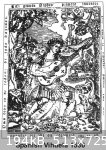

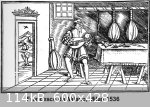
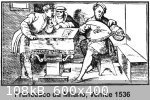
|
|
|
jdowning
Oud Junkie
    
Posts: 3485
Registered: 8-2-2006
Location: Ontario, Canada
Member Is Offline
Mood: No Mood
|
|
The length of the neck of the oud originally posted by Richard is 297 mm but 7- 11/16 inch converts to 195.28 mm which is about 1/4 total length of
the instrument so this latter dimension is to be taken as the correct dimension in calculating the original string length and geometry of the oud that
appears at first glance to be a modified version of the 14th C Persian described in 'Kanz al-Tuhaf'.
So the dimensions to be followed are neck length = 195 mm, body length = 568 mm, body width = 323 mm, body depth = 203 mm.
Scaling from Ronny Anderson's image of the fingerboard gives a neck joint width of 5.7 mm - about right for a 6 course oud.
|
|
|
jdowning
Oud Junkie
    
Posts: 3485
Registered: 8-2-2006
Location: Ontario, Canada
Member Is Offline
Mood: No Mood
|
|
The fret locations on the fingerboard are clear enough from the close up image provided by Ronny and, as it appears to be relatively free of optical
distortion, it should be OK to scale dimensions.
The attached image compares fret positions as measured with 12 Tone Equal Temperament and Pythagorean.
Equal temperament spacing is historically appropriate for lute fretting as is Pythagorean spacing for 14th C oud (but does not include intermediate
'quarter tone' frets).
It can be seen that the finger board is long enough to accommodate 7 frets spaced according to these systems. The 7th fret position is at 195 mm from
the nut so the string length - deduced from the fret positions - is 3X that dimension or
585 mm (which agrees with Richard's estimate of 586 mm).
It should be noted that in practice the frets may deviate slightly from the calculated positions dependent upon the fret gut diameter, string diameter
and string tension. The displacement of the measured fret positions towards the bridge is consistent with practical fretting based upon 12 TET - i.e
lute fretting. So, whoever tied the frets on the neck intended to play the instrument polyphonically like a lute - not like an oud.
Oddly - as Richard notes - this string length seems to be out of proportion to the overall dimensions of the oud. Indeed the bridge would have to be
placed somewhere near the widest part of the sound board to conform to this string length. This implies that the oud was not originally made to be
fretted but had been altered at some time by repositioning the bridge to shorten string length so that seven frets could be accommodated on the neck -
perhaps by a European 'early music' researcher in the late 19th/ early 20th C looking for an instrument on which to explore the surviving lute
repertoire?
So, if the existing fret positions cannot be used to deduce the original string length of the oud where do we go from here?

|
|
|
jdowning
Oud Junkie
    
Posts: 3485
Registered: 8-2-2006
Location: Ontario, Canada
Member Is Offline
Mood: No Mood
|
|
The perfect proportions of an oud - as given by the mediaeval period writers Ikhwan al- Safa (10th C) and Kanz al-Tuhaf
(14th C) are that the neck (ie fingerboard) length is 1/4 of the total length of a oud. This is of sufficient length to accommodate the range of fret
positions dictated by these early theoreticians ie up to the last fret - the 'fourth finger fret' - equivalent to the fifth fret position on the 12
Tone Equal Temperament scale. The early German lutes of the late 15th/ early 16th C also originally only had five frets on the neck.
The Al-Tounjy oud is of this proportion except that the neck has been made slightly longer in order to create a sufficient neck joint/ finger board
width to accomodate 6 double courses (the earliest ouds only had four or five courses).
Although the Al-Tounjy oud - made in 1889 - did not originally have frets, the fourth finger position would have been located close to the neck joint
- its exact position being dependent upon string length.
Ronny Anderson's 'full face' image of the oud suffers from some optical distortion so it is not possible to scale exactly from the image. However,
taken together with Richard's measurements it is possible to make a reasonable guess at what the original geometry may have been although this can
only be accurate to within say 2 to 5 mm due to the damaged condition of the oud and possible distortion of the bowl.
The attached image is the proposed geometry drawn to scale and is largely self explanatory. The upper sound board profile is the same as that given by
Kanz al-Tuhaf. The bridge position is 4 finger units (of about 20 mm) from the bottom of the bowl - the proportion given by the 14th C Ibn al-Tahhan
oud. This gives a string length of about 680 mm (shown as 675 mm which appens to be a significant string length for both the early ouds as well as
some of the late 17th C lutes - the relatively long string length providing optimum performance for gut bass strings).
The sound hole diameter and placement is a guess based upon the 16th C Maler and Frei lutes that had this long elongated profile.
For comparison see "Old Oud Compared to Old Lute Geometry" on this forum.
Given the similarity of geometries the original bracing of the surviving Maler sound board might be an indication of the bracing used on the Al-Tounjy
oud.
A convenient tool for calculating fret positions for a number of historical systems can be downloaded from the 'Lute Society of America' website. The
software does not work on older version of Microsoft Works but does so on the free open source 'OpenOffice' software.
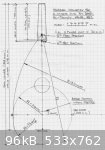
|
|
|
bulerias1981
Oud Junkie
    
Posts: 770
Registered: 4-26-2009
Location: Beacon, NY
Member Is Offline
Mood: John Vergara Luthier Lord of the Strings instrument making and repair
|
|
Found this "oud" at the museum of Jewish Heritage, in NYC. (No, I'm not Jewish)
The museum calls the oud "Turkish" and says it dates from late 1800's. I find this odd for a couple of reasons.
I know its hard to tell from the photo, but the bowl seems to be of a European lute, and is very shallow, not half round.
The rosettes are carved from the same piece that the top was made of. (like lutes) No holes were cut out and there are no additional materials which
the rose was made from, then glued on. This is not the case.
You will also notice frets just past the neck joint. Which have been planed down so that the surface of the soundboard there is flat.
I don't believe the bridge, pickguard, neck, or pegbox to be original.
Also hard to tell from this photo, small pearl star of David inlays on the fingerboard.
My thesis on this odd instrument is it might have been a lute, which was later modified to be played as an oud in Turkey. Whatever the case is, it
have had to come to the U.S. by Jewish immigrants.
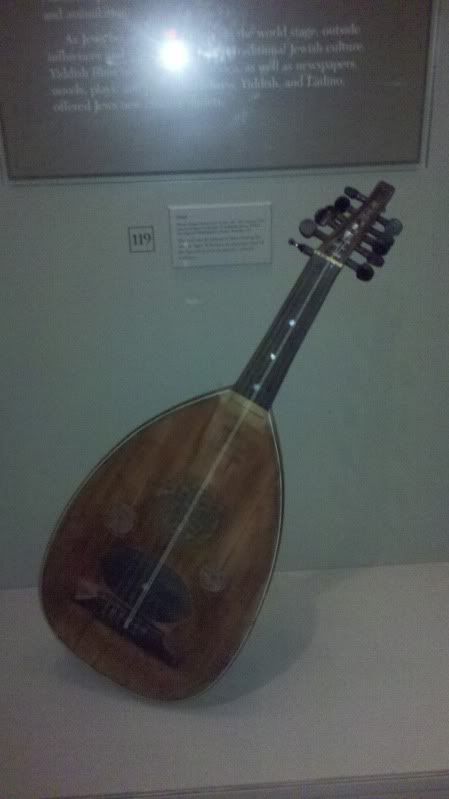
|
|
|
jdowning
Oud Junkie
    
Posts: 3485
Registered: 8-2-2006
Location: Ontario, Canada
Member Is Offline
Mood: No Mood
|
|
Hard to say from the image due to low resolution and foreshortening. It might originally have been one of those German lute/ guitars made in the
second half of the 19th C. - later converted to an 'oud'. Note the massive guitar like bridge, frets on the sound board and inlay dots on the
fingerboard and sound board edge banding/purfling.
Or perhaps it was originally a Turkish 'lavta'?
The profile of the sound board could be either lute or oud but a shallow bowl is not characteristic of either instrument.
The peg closest to the nut on the bass side does not appear to be fitted to the side of the pegbox?! Also the peg box seems to be crescent shaped? -
but impossible to tell from the image.
|
|
|
bulerias1981
Oud Junkie
    
Posts: 770
Registered: 4-26-2009
Location: Beacon, NY
Member Is Offline
Mood: John Vergara Luthier Lord of the Strings instrument making and repair
|
|
the angle is a little funny, but the peg on the left is fitted into the pegbox as normal, and pegbox is the same angle and shape of standard oud
pegboxes.
|
|
|
jdowning
Oud Junkie
    
Posts: 3485
Registered: 8-2-2006
Location: Ontario, Canada
Member Is Offline
Mood: No Mood
|
|
So a Turkish 'Lavta' with shortened neck may be the answer?
|
|
|
Alfaraby
Oud Junkie
    
Posts: 796
Registered: 9-18-2009
Location: Holy Land
Member Is Offline
Mood: Cool
|
|
The label says: "Work of Baseel Al-Tonjy the carpenter in Aleppo in the year 1892."
Another famous family member (is it the same family ?) is Gabriel (Gabi) Totanjy, one of the best Qanoun makers ever.
Here it is : http://www.qanuns.net/Store.htm
5 k$ only !
Yours indeed
Alfaraby
alfarabymusic@gmail.com
|
|
|
jdowning
Oud Junkie
    
Posts: 3485
Registered: 8-2-2006
Location: Ontario, Canada
Member Is Offline
Mood: No Mood
|
|
For my records, is the date on the label 1889 or 1892?
|
|
|
ALAMI
Oud Junkie
    
Posts: 645
Registered: 12-14-2006
Location: Beirut
Member Is Offline
Mood: No Mood
|
|
I am too puzzled by our friend Al Faraby post, for me it is clearly written 1889 in good and clear Arabic handwriting.
|
|
|
Alfaraby
Oud Junkie
    
Posts: 796
Registered: 9-18-2009
Location: Holy Land
Member Is Offline
Mood: Cool
|
|
Sorry sorry sorry !
Sometimes, humans do make mistakes, even your friend Alfaraby 
It is 1889 obvious & clear enough, an evidence to human weaknesses
Yours indeed
Alfaraby
alfarabymusic@gmail.com
|
|
|
jdowning
Oud Junkie
    
Posts: 3485
Registered: 8-2-2006
Location: Ontario, Canada
Member Is Offline
Mood: No Mood
|
|
Thanks for the clarification Alfaraby - not so obvious to those of us who do not read Arabic.
Inexplicable errors are not a sign of weakness among your friends on this forum!
|
|
|
| Pages:
1
2
3 |